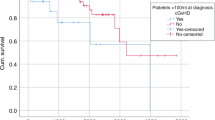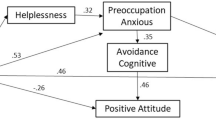Abstract
Recent research has shown that cancer patients undergoing bone marrow transplantation (BMT) experience moderate to severe mouth pain due to treatment-related mucositis in spite of morphine therapy. Treatment-related emotional distress in BMT patients is also described widely. This study examined several biomedical, psychological and social variables as possible predictors for the intensity of treatment-related mouth pain and anxious mood in 63 cancer patients undergoing BMT or stem cell transplantation (SCT) within a prospective longitudinal design. Biomedical predictors included biomedical risk, mucositis, the mode of transplantation, total body irradiation, age and gender. Psychological predictors were depression (BDI), BMT-related distress, chronic stress and resources in everyday life (KISS), pain-related coping behaviour (KPI-17) and social support (ISSS). Among the social variables we evaluated education, being married and the living situation. Criteria variables were the intensity of mouth pain and anxious mood which were assessed daily by numeric self-rating scales for 24 days after transplantation. Results of stepwise multiple regressions indicated that psychological and social variables were important predictors of mouth pain, besides biomedical variables. Whereas the biomedical variables revealed the most predictive power during the second week after BMT, psychological predictors were more important during the early and late phases of the treatment. Daily anxious mood was best predicted by psychological and social variables. Among the biomedical variables mucositis was most strongly related to mouth pain besides mode of transplantation, risk, TBI and age. Among the psychological variables BMT-related distress was the most important predictor, with resources in private life or at work and pain-related coping modes as further significant predictors. These results imply that relevant predictors should be assessed as high risk factors for an increased vulnerability for treatment-related side-effects before treatment starts indicating an additional offer of psychological treatment in high risk patients.
Bone Marrow Transplantation (2002) 29, 341–351. doi:10.1038/sj.bmt.1703385
This is a preview of subscription content, access via your institution
Access options
Subscribe to this journal
Receive 12 print issues and online access
$259.00 per year
only $21.58 per issue
Buy this article
- Purchase on Springer Link
- Instant access to full article PDF
Prices may be subject to local taxes which are calculated during checkout

Similar content being viewed by others
References
Chapman CR, Kornell JA, Syrjala KL . Painful complications of cancer diagnosis and therapy In: CH Yarbro, D McGuire (eds) Cancer Pain Management Grune and Stratton: Orlando 1987 pp 47 67
Chapko MK, Syrjala KL, Schilter L et al. Chemoradiotherapy toxicity during bone marrow transplantation: time course and variation in pain and nausea Bone Marrow Transplant 1989 4: 181 186
Gaston-Johannson F, Franco T, Zimmerman L . Pain and psychological distress in patients undergoing autologous bone marrow transplantation Oncol Nurs For 1992 19: 41 48
Syrjala KL, Chapko ME . Evidence for a biopsychosocial model of cancer treatment-related pain Pain 1995 61: 69 79
Breitbart W, Payne DK . Pain In: Holland J (ed.) Psychooncology Oxford University Press: Oxford 1998 pp 450 465
Ahles TA, Blanchard EB, Ruckdeschel JC . The multidimensional nature of cancer related pain Pain 1983 17: 277 288
Glajchen M, Fitzmartin RD, Blum D, Swanton R . Psychosocial barriers to cancer pain relief Cancer Pract 1995 3: 76 82
Zimmerman L, Turner Story K, Gaston-Johansson F, Rowles JR . Psychological variables and cancer pain Cancer Nurs 1996 19: 44 53
Schacham S, Reinhardt LC, Raubertas RF, Cleeland CS . Emotional states and pain: intraindividual and interindividual measures of association J Behav Med 1983 6: 405 419
Koopman C, Hermanson K, Diamond S et al. Social support, life stress, pain and emotional adjustment to advanced breast cancer Psycho-Oncol 1998 7: 101 111
Hobfall SE . Conservation of resources. A new attempt to conceptualizing stress Am Psychol 1989 44: 513 524
Baker F, Wingard JR, Curbow B et al. Quality of life of bone marrow transplant long-term survivors Bone Marrow Transplant 1994 13: 589 596
Meyers CA, Weitzner M, Byrne K et al. Evaluation of the neurobehavioral functioning of patients before, during and after bone marrow transplantation J Clin Oncol 1994 12: 820 826
Molassiotis A, van den Akker OBA, Milligan DW et al. Psychological adaptation and symptom distress in bone marrow transplant recipients Psycho-Oncology 1996 5: 9 22
Spiegel D, Bloom JR . Pain in metastatic breast cancer Cancer 1983 52: 341 345
Hasenbring M . Chronifizierung bandscheibenbedingter Schmerzen. Risikofaktoren und gesundheitsförderndes Verhalten Schattauer Verlag: Stuttgart 1992
Hasenbring M, Marienfeld G, Kuhlendal D, Soyka D . Risk factors of chronicity in lumbar disc patients. A prospective investigation of biologic, psychologic, and social predictors of therapy outcome Spine 1994 19: 2759 2765
Dunkel-Schetter C, Feinstein LG, Taylor SE, Falke RE . Patterns of coping with cancer Hlth Psychol 1992 11: 79 87
Melzack R . The McGill Pain Questionnaire: major properties and scoring methods Pain 1975 1: 277 299
Rosenstiel AK, Keefe FJ . The use of coping strategies in chronic low back pain patients: relationship to patient characteristics and current adjustment Pain 1983 17: 33 44
Wilkie DJ, Lovejoy N, Dodd M, Tesler M . Cancer pain intensity measurement: concurrent validity of three instruments-finger dynanometer, pain intensity number scales, visualanalogue scale Hospice J 1990 6: 1 13
Grebner M, Breme K, Rothoerl R et al. Coping und Genesungsverlauf nach lumbaler Bandscheibenoperation Der Schmerz 1999 13: 19 30
Burton AK, Tillotson KM, Main CJ, Hollis S . Psychosocial predictors of outcome in acute and subchronic low back trouble Spine 1995 20: 722 728
Linton St J . A review of psychological risk factors in back and neck pain Spine 2000 25: 1148 1156
Hasenbring M . Predictors of efficacy in treatment of chronic low back pain Curr Opin Anaesthes 1998 11: 553 558
Turk DC . The role of demographic and psychosocial factors in transition from acute to chronic pain In: Jensen TS, Turner JA, Wiesenfeld-Hallin Z (eds.) Proc 8th World Congress Pain IASP Press, Seattle 1996 pp 185 214
Schubert MM, Williams BE, Lloid ME et al. Clinical assessment scale for the rating of oral mucosal changes associated with bone marrow transplantation: development of an Oral Mucositis Index Cancer 1990 69: 2469 2477
Lorentz J, Baumgärtner U, Zander AR, Bromm B . Differenzierung von schmerz- und morphinbedingter Beeinträchtigung kognitiver Leistungen und subjektiver Befindlichkeit bei Knochenmarktransplantationspatienten Der Schmerz 1995 9: 1 9
Stimmel B . Pain, Analgesia and Addiction Raven Press, New York 1993
Beck AT, Ward CH, Mendelson M et al. An inventory for measuring depression Arch Gen Psych 1961 4: 561 571
Geisser ME, Roth RS, Robinson ME . Assessing depression among persons with chronic pain using the Center for Epidemiological Studies-Depression Scale and the Beck Depression Inventory: a comparative analysis Clin J Pain 1997 13: 163 170
Syrjala KL, Cummings C, Donaldson GW . Hypnosis or cognitive behavioral training for the reduction of pain and nausea during cancer treatment: a controlled clinical trial Pain 1992 48: 137 146
Syrjala KL, Donaldson GW, Davis MW et al. Relaxation and imagery and cognitive-behavioral training reduce pain during cancer treatment: a controlled clinical trial Pain 1995 63: 189 198
Kammer D . Eine Untersuchung der psychometrischen Eigenschaften des deutschen Depressionsinventars BDI Diagnostika 1983 29: 48 60
Hasenbring M, Kurtz B, Marienfeld G . Erfahrungen mit dem Kieler Interview zur subjektiven Situation – KISS In: Verres R, Hasenbring M (eds) Psychosoziale Onkologie Springer, Berlin 1989 pp 68 85
Hasenbring M, Arp K, Gassmann W et al. Belastungen, Ressourcen und Krankheitsverarbeitung im Verlauf einer Polychemotherapie: Erste Ergebnisse einer prospektiven Längsschnittstudie In: Muthny F, Haag G (eds) Onkologie im psychosozialen Kontext Asanger, Heidelberg 1993 pp 99 117
Hasenbring M, Marienfeld G, Kuhlendal D, Soyka D . Risk factors of chronicity in lumbar disc patients. A prospective investigation of biologic, psychologic, and social predictors of therapy outcome Spine 1994 19: 2759 2765
Revenson TA, Majerovitz SD . Spouses’ support provision to chronically ill patients J Soc Pers Rel 1990 7: 575 586
Ramm G, Linhart D, Zander AR, Hasenbring M . The German version of the illness-specific social support scale and the test-statistical evaluation on the basis of patients undergoing bone marrow transplantation Psycho-Oncology 1998 7: 15 (Abstr.)
Duncan GH, Bushnell MC, Lavigne GJ . Comparison of verbal and visual analogue scales for measuring the intensity and unpleasantness of experimental pain Pain 1989 37: 295 303
Wilkie DJ, Keefe FJ . Coping strategies of patients with lung cancer-related pain Clin J Pain 1991 7: 292 299
Jensen MP, Turner LR, Turner JA, Romano JM . The use of multiple-item scales for pain intensity measurement in chronic pain Pain 1996 67: 35 40
Vlaeyen JWS, Linton SJ . Fear-avoidance and its consequences in chronic musculoskeletal pain: a state of the art Pain 2000 85: 317 332
Johnson MH, Petrie SM . The effects of distraction on exercise and cold pressure tolerance for chronic low back pain sufferers Pain 1997 69: 43 48
Hasenbring M . Attentional control of pain and the process of chronification In: Sandkühler J, Bromm B, Gebhart GF (eds) Progress in Pain Research 2000 pp 525 534
McCaul KD, Haugtvedt C . Attention, distraction, and cold pressor pain J Pers Soc Psychol 1982 43: 154 162
Stam H, Gross C, Rosenal L et al. Aspects of psychological distress and pain in cancer patients undergoing radiation therapy In: HL Fields (ed) Advances in Pain Research and Therapy vol. 9: Raven Press, New York 1985 pp 569 573
Neuser J . Psychische Belastung unter Knochenmarktransplantation: empirische Verlaufsstudien an erwachsenen Leukämiepatienten Frankfurt am Main: Europäische Hochschulschriften 1989
Berkman LF, Syme SL . Social networks, host resistance, and mortality: a nine-year follow-up study of almeda county residents Am J Epidemiol 1979 109: 186 204
Veiel HOF, Crisand M, Stroszeck-Somschor H, Herrle J . Social support networks of chronically strained couples: similarity and overlap J Soc Pers Rel 1991 8: 279 292
Faucett JA . Depression in painful chronic disorders: the role of pain and conflict about pain J Pain Sympt Management 1994 9: 520 526
Acknowledgements
This work was supported by a grant of the German Research Foundation (DFG No. Za 170/2). The authors greatly thank Karen L Syrjala, PhD, Seattle, USA, for numerous discussions, comments and support.
Author information
Authors and Affiliations
Rights and permissions
About this article
Cite this article
Schulz-Kindermann, F., Hennings, U., Ramm, G. et al. The role of biomedical and psychosocial factors for the prediction of pain and distress in patients undergoing high-dose therapy and BMT/PBSCT. Bone Marrow Transplant 29, 341–351 (2002). https://doi.org/10.1038/sj.bmt.1703385
Received:
Accepted:
Published:
Issue Date:
DOI: https://doi.org/10.1038/sj.bmt.1703385
Keywords
This article is cited by
-
Cancer survivorship care for young adults: a risk-stratified, multicenter randomized controlled trial to improve symptoms
Journal of Cancer Survivorship (2022)
-
Everyday life following hematopoietic stem cell transplantation: decline in physical symptoms within the first month and change-related predictors
Quality of Life Research (2018)
-
Mild Depression in Low Back Pain: the Interaction of Thought Suppression and Stress Plays a Role, Especially in Female Patients
International Journal of Behavioral Medicine (2018)
-
Pretransplant Psychological Assessment for Stem Cell Treatment
Journal of Health Service Psychology (2018)
-
An online randomized controlled trial, with or without problem-solving treatment, for long-term cancer survivors after hematopoietic cell transplantation
Journal of Cancer Survivorship (2018)



